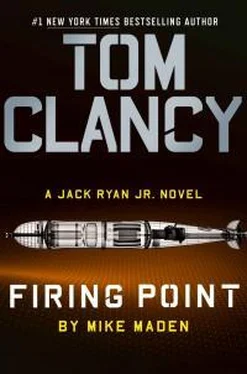“Coincidence, or good planning,” Ryan said. “I’m not sure which yet.”
“SBIRS is just one part of MASINT,” Foley said. “What has MASINT told us?”
Measurement and signature intelligence assets, including SBIRS, were the ground, sea, air, and satellite systems that provided real-time tactical and strategic intelligence gathering. MASINT assets deployed a wide range of seismic, acoustic, thermal, optical, and other sensors capable of detecting any and all forms of kinetic events. Some assets covered entire continents; others were tasked with missions as small as a few meters. Most were targeted at known threat vectors like North Korea or the Middle East.
“MASINT hasn’t shown us anything, ma’am. Gamma waves, X-rays, radio waves, infrared, sonar, radar—nothing along the entirety of the electromagnetic spectrum locates any kind of air or sea combat vehicle in the vicinity of these sinkings.”
“No indication of nuclear, chemical, or biological attack?” Ryan asked.
“None that we detected remotely. Putting assets on-site would give us a more definitive reading. These locations are way the hell out in the middle of nowhere.”
—
Ryan turned to Admiral Talbot. “You’ve just told us what we don’t know. Let’s change tack and talk about the facts we do know.”
“Yes, sir.” He clicked his laser pointer and a live digital map popped onto one of the other wide-screen monitors. It displayed the Pacific Ocean with arrowhead-shaped graphical images of current vessel shipping traffic. A key in the bottom right-hand corner showed vessel type by color. Cargo ships were green, fishing vessels were pink, oil tankers were red, and so forth.
“What you’re looking at is a live display of vessels broadcasting automatic identification system, AIS, signals all over the Pacific.
“The vessels are equipped with transceivers that transmit a variety of ships’ data including name, speed, location, et cetera. AIS is both land and satellite based, and supplements other ship-based navigational aids such as radar, gyrocompass, and Global Navigation Satellite System receivers.”
“How many ships broadcasting AIS are we talking about?” Ryan asked. “Globally?”
Admiral Talbot widened the screen to show the entire globe. Tens of thousands of multicolored “arrowheads” appeared on every ocean, most congested around the coastlines of every continent, save Antarctica. The North Atlantic and western Pacific were particularly congested.
“Approximately one hundred thousand vessels broadcast an AIS signal yearly, though of course, not every such equipped vessel is currently at sea.”
Arnie whistled. “That’s a lot of damn boats to keep track of.”
“It is.” Talbot clicked his laser pointer and all of the “live” arrowheads disappeared. All that remained on-screen were six green cargo ship arrowheads overlaid with red X’ s. He pointed to each of them as he spoke.
“These are the locations of the six vessels sunk in this remote region of the South Pacific. It’s an area of approximately one thousand square miles located about three thousand miles due south of San Diego and the same distance due west of Peru. The sunken ships all sailed under five different flags of convenience. No witnesses or survivors. No known means of destruction, though it appears the destruction was total. Based on our analysis, each ship was sunk by a single, catastrophic strike.”
“Don’t ships of that size have ‘black boxes’ like passenger aircraft?” Arnie asked.
“Yes, otherwise known as voyage data recorders. Some are designed to float free of a vessel but most are fixed. It’s entirely possible somebody boarded each vessel and disabled or removed the VDRs. The other possibility is that a massive event could destroy a ship and send it to the bottom without allowing enough time for the VDR to broadcast a distress signal.”
“If we find the wreckage, can we send down divers and recover the VDR?”
Talbot highlighted the first wreck. “This one is located in the most shallow area at just five thousand and sixty-five feet. Almost a mile.” His laser pointer ran to another. “The deepest location is nearly seven thousand feet below the surface. A human diver simply isn’t possible.
“Our only chance is to get a deepwater submersible into the area. A visual inspection of the wreckage would be possible—but only if the submersible is able to navigate the tangle of steel, cables, containers, and other debris that might block its ingress.”
“But if we do recover the VDRs? That’ll tell us what we need to know, right?” Arnie asked.
“Unfortunately, most of the information a VDR would provide would only duplicate the AIS data we already have. Some VDRs record sound and radio transmissions, which could prove useful if the ship communicated with whoever attacked it. On the other hand, a sophisticated intruder on board the vessel would know to erase the data with a simple magnet.”
Arnie frowned with frustration. “But in general, are you confident that these six markers are the likely locations of the sunken ships?”
“Assuming the vessels weren’t simply boarded, their AIS turned off, and then sailed to a distant location, then, yes, ‘likely locations’ is a good bet.”
22
“To summarize,” Ryan began. “We’re fairly confident we know where these ships were sunk but we still don’t know how. John, what’s your best guess as to the weapons platform? Maybe that will get us closer to ‘who.’”
“If you put a gun to my head? A submarine makes the most sense.”
“Why?”
“My gut. Nothing more. I know what boats can do and this fits the profile.”
“Does IUSS tell us it’s a sub?” Ryan asked. He was referring to the Navy’s submarine detection program, the Integrated Undersea Surveillance System. IUSS included SOSUS, garage-size hydrophone arrays planted on the seabed, and SURTASS, plane-based sonar buoys and towed array ships.
“The short answer is, IUSS sensors weren’t available in the area of the sinkings.”
Ryan shook his head, smirking, and leaned back in his chair. “Of course not.”
“Another coincidence, boss?” Arnie asked.
“For what it’s worth, we did pick up a Russian ELF transmission a few days ago. They don’t use it very often so we pay attention when they do.”
“ELF?” Arnie asked.
“Extremely low frequency radio transmission. It’s used to communicate with submerged submarines over huge distances—almost anywhere on the planet. I’m not saying the ELF transmit is connected to this but it’s one more hash mark in favor of my gut.”
“Buck Logan thinks the Russians are behind this,” the President said. “I’m not convinced, but if you think it’s a sub, it’s worth discussing. Let’s start with why it could be the Russians.”
SecDef Burgess said, “They certainly have the national-technical means to do so, especially if it’s a sub. And they’ve just launched the K-329 Belgorod, assigned to their Pacific Fleet.”
“Is it in the area?” Foley asked.
“No, but it doesn’t have to be,” Talbot said. “The Belgorod is an Oscar - II class submarine, the longest in the world—bigger even than the Red October, which was a Typhoon -class. But the Belgorod isn’t a missile boat. It’s a ‘special mission’ boat, designed specifically to carry two deepwater submersible research vessels along with six Poseidon torpedoes.”
“Poseidons?” Adler asked.
“Nuclear-powered drone torpedoes with an estimated range of over six thousand miles, and an operational depth of up to ten thousand feet,” the admiral said. “The Russians claim that Poseidon can reach underwater speeds of a hundred knots whether it’s carrying a hundred-megaton nuclear or a conventional warhead.”
Читать дальше











![Александр Ирвин - Tom Clancy’s The Division 2. Фальшивый рассвет [litres]](/books/417744/aleksandr-irvin-tom-clancy-s-the-division-2-falsh-thumb.webp)